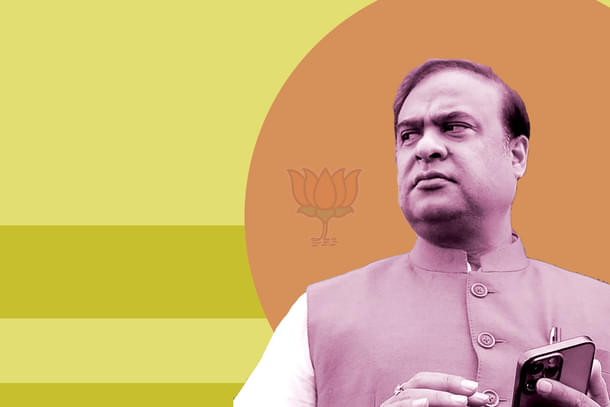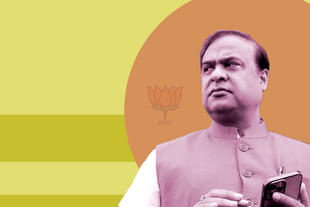Politics
One Lakh Government Jobs: Why Other BJP State Governments May Want To Replicate This Assam Project
Nabaarun Barooah
Jul 29, 2024, 06:26 PM | Updated Aug 01, 2024, 11:02 AM IST
Save & read from anywhere!
Bookmark stories for easy access on any device or the Swarajya app.


In the postscript of the 2024 Lok Sabha election, many political commentators have questioned the organisational and communicative fissures within the Bharatiya Janata Party (BJP) in several key states of the country.
In response, the party convened a high-level meeting of their chief ministers in New Delhi, aimed at strategic recalibration and administrative realignment.
Notably, this summit spotlighted an emerging governance paradigm from an unlikely source — Assam.
During the conclave, Assam's Chief Minister, Dr Himanta Biswa Sarma, garnered significant commendation from senior BJP leadership and fellow chief ministers alike.
Prime Minister Narendra Modi's explicit praise for Sarma, particularly highlighting the creation of 1 lakh government jobs in Assam, especially at a time when questions are being raised about unemployment levels in the country, underscored the Chief Minister's administrative acumen and innovative governance.
Prime Minister Modi's directive for Sarma to present the details of this employment programme to other state leaders signifies a potential paradigm shift, favouring the Assam Model as a blueprint for national replication.
This endorsement marks a pivotal moment for the BJP, coming on the heels of the party's electoral setbacks and the perceived inadequacies of various other state models, such as those on the opposite ends of the spectrum of capital expenditure and welfare expenditure, or infrastructure versus freebies.
The Assam Model, characterised by targeted employment initiatives and effective governance while maintaining both healthy capex and social security, is being positioned as a template for broader national implementation.
Dr Sarma’s prominence at the Delhi meeting, seated in the front row alongside the central leadership, symbolises his rising influence and the party’s strategic pivot.
How Assam is Providing 1 Lakh Government Jobs
The Assam Model’s central tenet is its aggressive job creation strategy, which has been instrumental in addressing unemployment and fostering economic growth.
However, this was not always the case. Prior to 2021, Assam faced significant challenges in its public sector recruitment processes, marked by numerous vacancies across various government departments.
Inefficiencies were exacerbated by the concurrent examinations conducted by different departments, leading to candidate confusion and difficulties in maintaining examination timelines.
These issues were compounded by numerous court cases related to examination procedures and reservation policies, along with allegations of corruption that undermined the credibility of the recruitment process.
The redundancy of multiple examinations consumed valuable resources and time, hindering effective public service delivery due to a lack of qualified personnel.
In response to these challenges, the government, led by Dr Sarma, implemented a swift, transparent, and cost-effective centralised recruitment system.
This reform included establishing direct recruitment commissions for analogous posts and state-level recruitment commissions for Class III and IV positions (SLRC-III and SLRC-IV).
By adopting a combined appointment procedure that grouped vacant posts by qualification and conducted a common written examination for similar educational qualifications, the government aimed to standardise the evaluation process and cut costs.
This was complemented by separate skill tests or oral interviews for final selection, ensuring a uniform approach to recruitment across various departments.
However, the initiative faced several challenges that required strategic interventions.
One major difficulty was coordinating with 48 different departments to consolidate vacancies, standardise reservation criteria, and harmonise eligibility requirements. This issue was addressed through a leadership-driven approach that streamlined processes and ensured consistency across departments.
Another significant challenge involved managing the written tests for 14 lakh candidates and conducting 58,000 interviews. The solution involved innovative measures to prevent unfair practices and setting up multiple interview boards capable of managing up to 1,000 interviewees daily.
By adopting such a comprehensive approach, the centralised recruitment initiative yielded substantial improvements in efficiency and transparency.
Consolidating recruitment drives into a single, streamlined process reduced government expenditure and conserved human resources. The extensive integration of technology into the recruitment process eliminated issues such as cheating and paper leaks, thus boosting public confidence in the state apparatus.
Candidates benefited from a unified application process and a consolidated view of vacancies, simplifying their experience and minimising the financial burdens associated with multiple application fees.
These combined efforts resulted in the successful placement of 97,454 government jobs across various sectors. This extensive recruitment drive not only filled vacancies but also broadened employment opportunities, thereby strengthening workforce capacity and enhancing public service delivery throughout the state.
The next round of examinations, scheduled for September, aims to fill another 7,600 vacancies, taking the total employment figure beyond 1 lakh.
This model's emphasis on practical, scalable solutions resonates with the BJP’s broader ideological framework of self-reliance and economic development.
By generating substantial employment opportunities, the Assam government has not only mitigated economic distress but also bolstered social stability and political goodwill.
Additionally, the Assam Model is underpinned by robust administrative mechanisms marked by transparency and accountability. Sarma’s governance style, characterised by a hands-on approach and responsiveness to public grievances, contrasts sharply with the bureaucratic inertia observed in larger states.
This model’s success is reflective of a decentralised yet coordinated administrative strategy that could be particularly effective in India's diverse federal structure.
The Emergence of a New Governance Paradigm
The BJP’s embrace of the Assam Model represents a significant evolution in its governance approach and marks a strategic reorientation.
As the party grapples with internal challenges and external criticisms, the successful implementation of Sarma’s employment programmes offers a promising roadmap for other states.
By prioritising economic development and administrative efficiency, the Assam Model could play a crucial role in redefining the BJP’s national strategy and restoring its electoral fortunes.
Nabaarun Barooah is an author and commentator.





